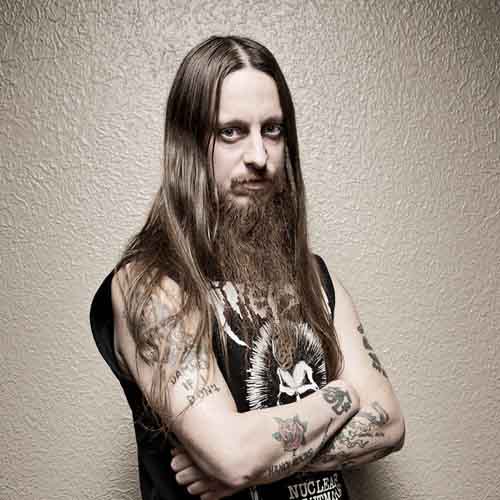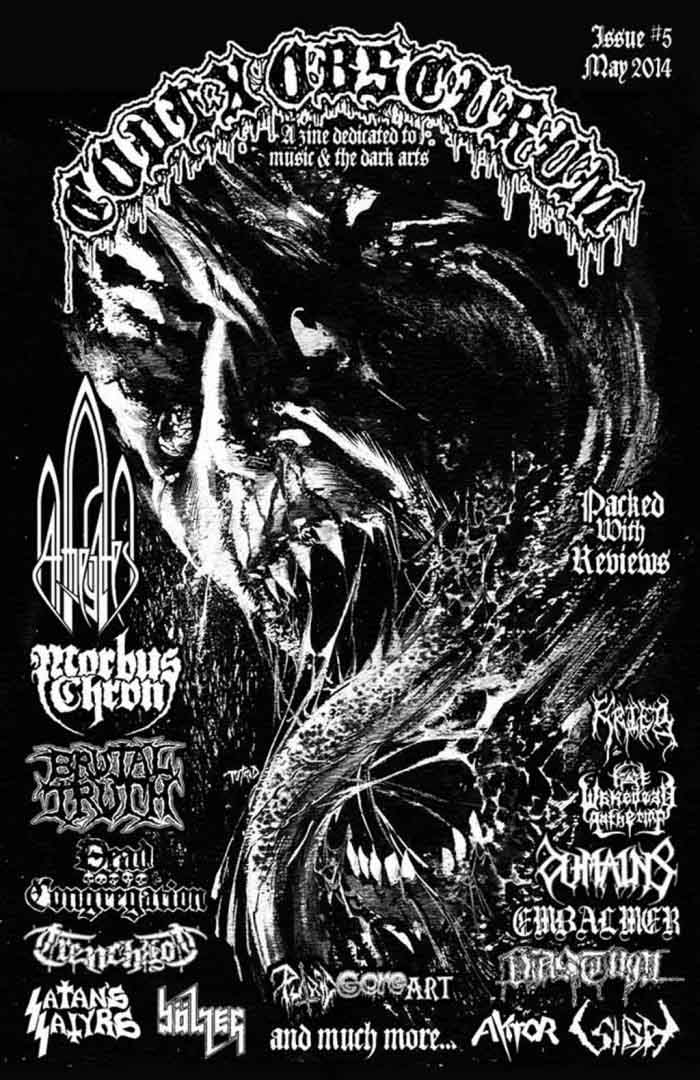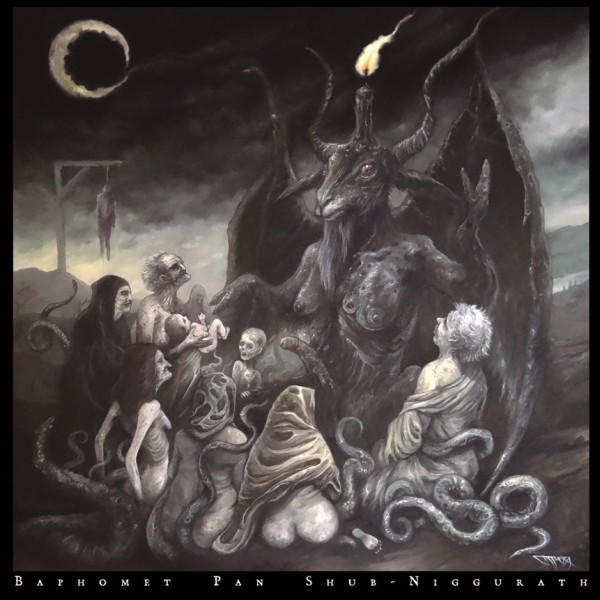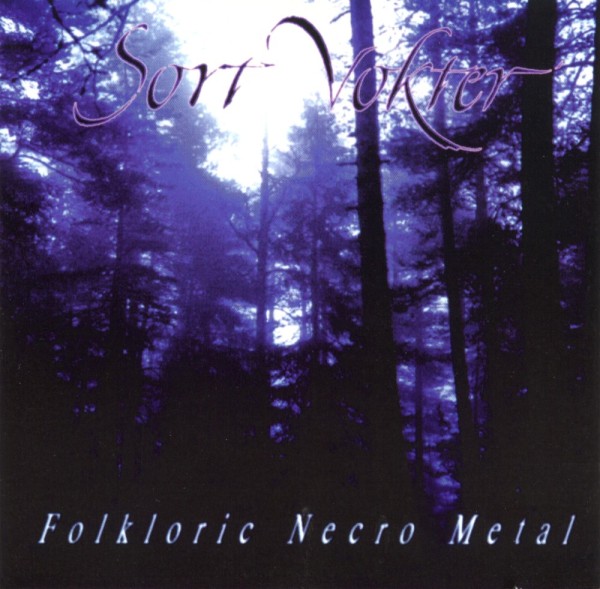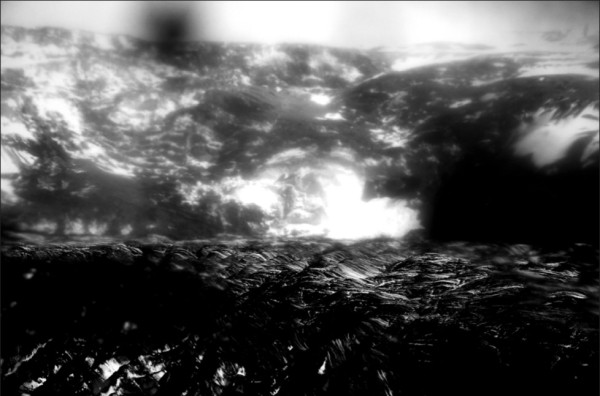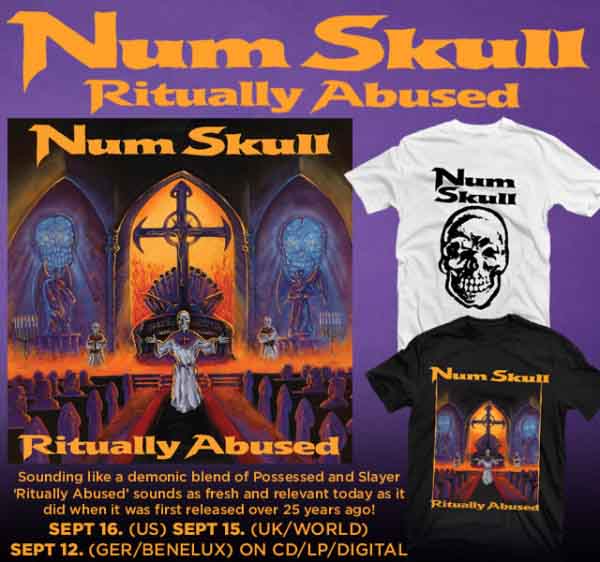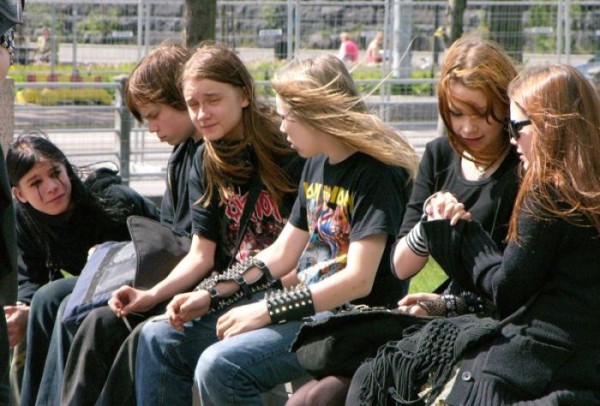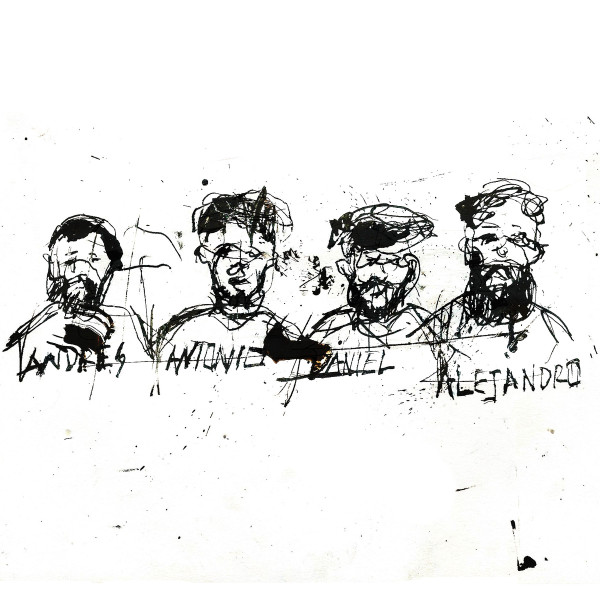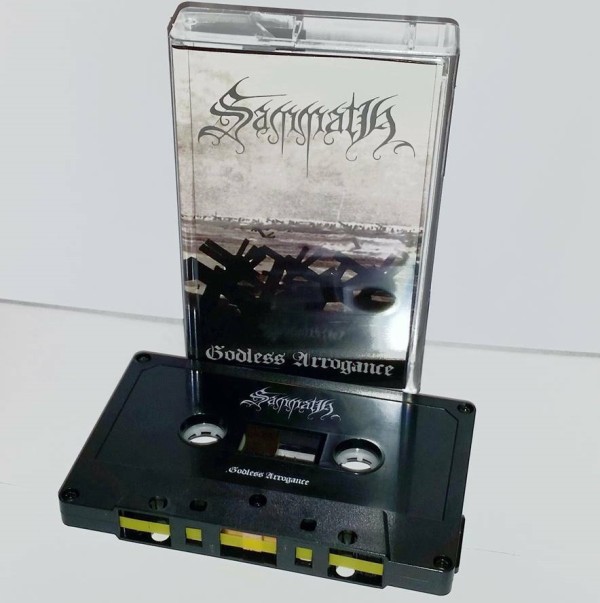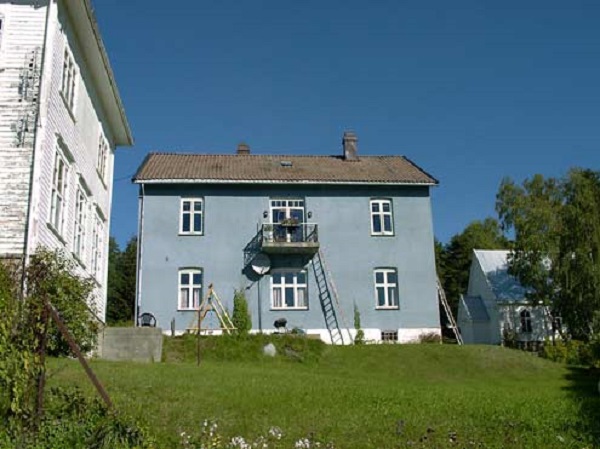
History reveals little about Nidhogg, the musician known for his contributions to Ildjarn, Sort Vokter and Ildjarn–Nidhogg. These projects, while initially rejected by an increasingly faddish black metal “scene,” quickly gained fans for their use of elegant short melodies within ambient songs of abrasive noise fused with aggressive Oi rhythms and black metal riffs.
Using short songs structured around the transitions of song inspired by lyrics, Nidhogg creates albums that immerse the listener in a dark world of excitement: like the primeval forest come alive, this music pulses with the poetry of life in the wild. It embraces the world as a living organism in the pre-Christian tradition and brings out the fierce natural instinct for survival and power as well as the ambiguous lack of safety inherent to the frontier. Expansive and transcendent, like all good black metal from the Norse tradition, it transports the listener away from a failed functionalist time into a mindset of possibility and exuberant cosmic exploration.
Much of black metal would benefit from seeing into the mind of this primal artist concerning his contributions to the aforementioned nature-metal projects and his own artistic endeavors. Read on for the thoughts of one of the last embodiments of a genuine black metal mentality…
How did you first meet Ildjarn, the person?
Me and Ildjarn met when starting secondary scool at Bø Gymnas, Telemark in 1988. We had the same interest in metal and started hanging out together and experimenting musically in different directions in the basement at Akkerhaugen where we recorded “Norse” and “Svartfråd“.
Can you describe the formation of the musical project, Ildjarn, and how you became involved?
Ildjarn is his own project, and he started recording under that moniker in the early 90’s. Me and Ildjarn had played together in different constellations, and Ildjarn also played with Samoth and Ihsahn in Thou Shalt Suffer. After doing all sorts of stuff, even some noise/experimental, me and Ildjarn focused on the Black Metal sound, as it was where our hearts lay. I found some old lyric sheets which indicates that we initially called ourselves Nivlheim, but at the time of “Norse” we had landed on Ildjarn — Nidhogg, because Ildjarn had already started using the Ildjarn-name.
Nature is a big part of my life, and I’m not comfy living in the city. I’m lucky enough, now, to live right by the forest, surrounded by small lakes and mountains. Nature evokes most of all awe and calmness.
We recorded Norse in two sessions in 1993 which is discernible on the differences on my vocals between the a and the b-side. Samoth liked it and decided to release it on Nocturnal Art Productions. Ildjarn continued releasing his own records, and me and him then sporadically made music together, culminating with “Hardangervidda“.
What sort of guiding influence did you have on Ildjarn, and how was this different from your role in Ildjarn–Nidhogg?
I didn’t have any guiding influence on Ildjarn. He is very much his own man. But we had the same love for the proto-scandinavian black metal sound, shaped by athory and picked up by Mayhem with Dead, and so on.
Ildjarn — Nidhogg was a 50/50 collaboration, and we always had clear idea of where we wanted to go, both with the metal and the ambient stuff. The demos I uploaded were my concepts, like the Ildjarn stuff was his, so they were planned to be released as Nidhogg-demos.
Regarding vocal duties, what were your contributions in this area to Ildjarn–Nidhogg?
I did the vocals on all Ildjarn-Nidhogg recordings and also on Sort Vokter except for on “Hatefulle Tanker…” where I, Ildjarn and Harald all sang, and “Bak to Lysende Øyne” where both me and Ildjarn sang, but he did the prime vocals. The last song also appears on Svartfråd and I did the vocals on that version.
You previously mentioned that you were the collaborator with Ildjarn for the visual elements of various projects. What album covers did you create and is the impetus and process of creating them distinct from the musical process?
We did the layouts for many of Ildjarn’s albums on a computer I had access to. I mainly did the layout and was only artistically involved in the creation of Ildjarn transforming into a boar on the Strength and Anger-cover, Nob of NOB Art, did most of that, though. Nob was a friend of ours from Notoddden, and is the artist featured on albums such as Nocturnal Visions, “Minnesjord – The Dark Soil” and “93.” He also did the graphics for Forest Poetry along with another outstanding artist by the name of Javier Guerra who did the frontcover and at least two other illustrations Ildjarn used.
I’d also like to mention a fourth person who were also a close friend in Notodden at that time, who wrote the poem that was used for lyrics on “Eksistensens Jeger.” KK, as I’ll call him is now an established and published artist and writer. In Notodden me, Ildjarn, Nob and KK used to hang around, as three of us attended Telemark Lærehøgskole (teachers college) there. The pictures on the Sort Vokter-cover were taken in the forest behind the school, an area that stretches several miles. It was a place where especially me and Nob had many excursions, often in drug-induced states. I’m not exaggerating if I say I had some semi-paranormal experiences in that forest. This was also a feeling we tried to transfer to the cover.
What attracted you to metal in the first place?
Like all over Norway in the 80s, we were some kids in school who started listening to metal, copying tapes and borrowing music from each other. The energy and aggression was the appeal, of course. It was a rapid progression via Twisted Sister, Accept, AC/DC and such, to Metallica, Megadeth and Motörhead and then on to the more aggressive thrash as Slayer, Death Angel, Dark angel and Sabbat.
How did you first become entwined with the “black metal scene”? What was that time like, and what do you think of current “black metal” bands? What is missing from the present crop?
I was never involved in the scene, other than through Ildjarn and knowing members of Emperor. I met Ihsahn and Samoth, or Vegard and Thomas, first at a regional music talent show. They were playing as Xerasia and I was doing vocals with a band I sang in before me and Ildjarn did anything together. Later, we met in the basement at Akkerhaugen youth club, were Vegard and Thomas did all their initial projects. Besides some early exploits me and Ildjarn did together, we started started jamming as a hardcore/grindcore band with Thomas and Thorbjørn Akkerhaugen. Then when the Emperor concept was developed I was really blown away hearing them rehearse in the basement. It was clear they were on the verge of something. This was before all the ruckus started happening in the media.
When I got a tape copy of Vivaldi’s “The Four Seasons,” I played it repeatedly, and it’s amazing how it is really such a spot on musical interpretation of the progress through the year. Hardangervidda reflects a progression of time as well, from morning to night. The second half of “Sunrise” is very much inspired by Grieg’s “Morning mood.”
I think there are plenty of good acts around today, although one has to sift through more music now than before. I guess as with most genres that establish themselves, there are going to be waves and declines, but great stuff still gets released and will be released. The major challenge I guess, is to make something original in a genre that has been very much explored already. I think there are plenty of bands still around worthy of a listen, but now it’s of course a global thing, so one can just as easily find good bands anywhere else besides Norway, which is also stimulating to the genre.
What was the genesis of Sort Vokter? Were you involved from the beginning?
Sort Vokter was a spur of the moment idea and an opportunity between me and Ildjarn and two guys I knew from Notodden. Me and Harald (Heiinghund) ended up living in the same dorm and jammed some together on synth. He was a natural musician as was also Kyrre (Tvigygre). Sort Vokter was a concept we thought up in my flat, and as far as I can remember, we were all four there at that particular time.
The concept was doing very necro forest metal, or Folkloric Necro Metal, as we called the album. Kyrre worked as a studio technician in Grenland (Not Greenland ; )), and his boss granted him the studio for a weekend when we could do what we wanted. Sort Vokter was more a recorded jam session, than anything else, and most of the songs were composed/played through once and then recorded. Second or third takes would have greatly improved the album, but we were on a very tight time schedule. So “ignoring technical details” as the cover states, was more out of necessity than anything else.
Why has there been only one Sort Vokter album?
It was never meant to be anything more. We had known each other for some years before, and we stayed friends and connected until we one by one relocated from Notodden, but there was never any intention of making any sort of follow up to that one album.
You additionally worked on a synth album with Ildjarn, which was dedicated to the glory of Norwegian nature. What was the process of composing and recording this album? What does your experience of nature evoke?
Hardangervidda is a celebration of a particular mountain region in Norway, yes, where me and Ildjarn have been many times, both separately and together, since childhood. It’s vast and relatively flat, and trekking across it takes several days. The album was written in my flat in Notodden and recorded and mastered a couple of hundred meters down the same street, with help from Tore Hansen. Because it’s very layered it was never considered to record it live in studio. I had put away all the money I earned during one of those summers and bought a Roland XP-80 synth which also functioned as a 16-track midi recorder. Me and Ildjarn started working on the album in sessions, gradually tweaking the songs, doing both composition and production together. Some songs are my original ideas, some are his. There was a very clear idea from the onset of where the album was going to go, and it was really just a matter of doing all the work. The XP-80 was very easy, but time consuming to work with, as we didn’t hook it up to a computer. When we had finished the album we sent demo-CDs out to a couple of record companies. Origo sound actually said they’d consider it if we made alterations, which was of course out of the question. Ildjarn ended up releasing it on his Norse League Productions some time later.
Nature is a big part of my life, and I’m not comfy living in the city. I’m lucky enough, now, to live right by the forest, surrounded by small lakes and mountains. Nature evokes most of all awe and calmness. There’s nothing like the view after you’ve trekked up a mountain.
Last fall, Ildjarn released a split album with Hate Forest, entitled Those Once Mighty Fallen. You’ve recently been active on youtube and have released the demo recording which that recording was based from. What’s your reaction to this situation? Will you be releasing any more recordings in the future?
Well, like I’ve also stated, I was just surprised to realize it. It didn’t dawn on me until I actually checked with some old tapes laying in my basement, but how Osmose came to mislabel them, I don’t know. I think the songs may have been copied onto the same tape as some of Ildjarn’s stuff, years ago.
No, I don’t have any plans to release anything else, although I have lots of riffs and ideas laying around. I might pick up music again, since I still have the old synth, but hat will be when I’m less busy. I started on a concept-album in Notodden about the time of Hardangervidda, under the name Shadow Hungry Onto God (S.H.O.G.). This project was purely classical music, and is what I would start up with again, if anything.
Do you have any recordings of your own, separate from Ildjarn-Nidhogg, that you will release in the future?
I only have two proper recordings, one of which I don’t know where is at at the moment, from the S.H.O.G. project. The other is an edit of the B-side from a 7 inch I intended to release on my own, self-financed. The A-side was already finished, but I lost it due to an equipment failure. Since this meant that I lost weeks of work, I didn’t pick up on it again, after I relocated out of Telemark. I’ll upload the edited B-side on my YouTube-channel when I get the time. It’s quite psychedelic and nothing like anything me and Ildjarn did, except for the rhythms which are quite punkish.
Most striking within your music is the level of refined aggression sublimated through strong melodies. In our interview with Ildjarn, he told us that grindcore/industrial band Godflesh was a major influence on you. In particular, the album Streetcleaner seems to embody a similar spirit to your work. What is it about that band that resonates with you? What other bands provide the same state?
In terms of any direct influence Industrial Metal had on me, it would have to be on an industrial band me, Ildjarn and Thomas played as briefly, using the basements Oberheim drum machine for rhythms. The name was Fast Breeder. We recorded some rehearsals but never released any first demo.
Yeah, Godflesh is pure genius, in my opinion, and I actually got to speak with them when they played in Kristiansand. I liked Godflesh from the moment I heard them, Justins grinding guitar and use of feedback is perhaps the foremost appeal with Godflesh for me, but of course the whole soundscape. I highly recommend the double CD reissue of Streetcleaner and the release of old Fall of Because recordings.
I was also very much into Pitch Shifter until they changed their style, and their debut “Industrial” is amazing. SWANS is, of course, a band that one has to mention, and their “Cop” is a favourite of mine. Saw Throats “INDE$TROY” is also a classic. And the industrial/crustmonster Sonic Violence of course.
At the time I was listening much to these bands, I was also listening to the Young Gods, Foetus, Minister of Noise, Skinny Puppy, KONG, Front 242 and In Slaughter Natives. G.G.F.H. is one of my all time favourites.
What influence does classical music have on you? Are there any specific composers who inspired you?
I grew up in the 70s, which was a time when classical music was still always played on national broadcasting TV and radio. When I got a tape copy of Vivaldi’s “The Four Seasons,” I played it repeatedly, and it’s amazing how it is really such a spot on musical interpretation of the progress through the year. Hardangervidda reflects a progression of time as well, from morning to night. The second half of “Sunrise” is very much inspired by Grieg’s “Morning mood.”
For the S.H.O.G. project I’d say music that would evoke the same feeling as I was after with that, would be Peteris Vasks, Arvo Pärt, Randall Meyers and Berlioz. Just talking about the inspiration now, of course, these are untouchable composers working with symphonic orchestras. I was using dark synths underlaying the classical instruments.
Another composer that may not be very known or revered in metal-circles that had a huge impact on me is Michael Nyman. Being a member and also running film-clubs in Bø and Notodden, the movies by Peter Greenaway caught my interest in particular. Michael Nyman wrote the music to four consecutive films (and more later on), and these four film/music collaborations are often referred to together. “The Draughtmans Contract”, “ZOO”, “Drowning by Numbers” and the epic “The Cook, the Thief, the Wife and her Lover.” Greenaway also made “The Belly of an Architect” with Wim Mertens doing the music equally good, and in somewhat the same fashion.
But everything is corrupt, obviously, and I suppose the more you learn about the world, the more disheartened one gets at society. I have great faith in nature and animals though, as nature have adapted catastrophes unimaginable to us.
On that note, I’d like to mention my friend of Yayla of Türkey. If you want to check out his works here is his homepage: http://www.merdumgiriz.org/ and YouTube: https://www.youtube.com/user/merdumgirizworks
What do you think the purpose of art is? When you make music, do you have a conscious intention or goal driving you beyond the finalization of a piece?
I can’t speak for anyone else but myself, but for me it’s just an urge to express oneself through music. I started singing with a thrash band in ’87 and was hooked.
Looking back, there was always a clear intention with the music, and never any doubt as to what elements to include or exclude in the various concepts. I went in many different directions, by myself and with Ildjarn, although the metal and ambient stuff was the only released (except for a drone/folk demo I did). For instance, me and Ildjarn started working on a project we called “Myristic” which never came to fruition. The direction was very different from the metal stuff from Ildjarn — Nidhogg, but was nevertheless fully formed as a musical concept. At least for me, a composition or album is more like a road waiting to be discovered and mapped, rather than something one has to toil to invent. Once you start with an idea, everything rolls by itself, and reveals itself as you progress.
A drone/folk demo sounds fascinating. What was it entitled and when was it recorded? Can we expect this to ever surface again?
Well, I’d rather not reveal the title of it since it’s a totally unrelated project with Ildjarn session on bass. I recorded that one demo, which was also just meant to be a one off in 1994. It was a 9-track post-apocalyptic vision with references to Alfred Hitchcock’s “The Birds,” where scavenging birds were now the rulers and terrorizers of man.
I don’t think I’ll upload it as it was a totally unrelated thing.
What role did THC play in Sort-Vokter’s music? What value do you find in altered states of consciousness?
Yeah, we put that on the cover as a spoof. Ildjarn didn’t smoke, of course, like he has already stated, but I guess music and drugs were the common interests of the rest of us. It added a certain feel to the whole weekend, so to say. How much it influenced the creative side to the music, I don’t know, but it certainly makes ideas pop up easier.
Altered States of consciousness has been a lifelong interest of mine, and I currently live in place where the surrounding fields are littered with magic mushrooms in the autumn. I find psychedelics can reveal a lot, and can also possibly be a door opener to unseen realms.
I have a great regard for Terence McKenna and Rick Strassmans works, and there are also many other previous pioneers which could be mentioned. In England there were some very early nitrous-philosophers. Ken Keasy said: “I believe that with the advent of acid, we discovered a new way to think, and it has to do with piecing together new thoughts in your mind. Why is it that people think it’s so evil? What is it about it that scares people so deeply, even the guy that invented it, what is it? Because they’re afraid that there’s more to reality than they have ever confronted. That there are doors that they’re afraid to go in, and they don’t want us to go in there either, because if we go in we might learn something that they don’t know. And that makes us a little out of their control.”
Do you find anything valuable in human society? What about individual humans?
While I don’t share Ildjarn’s nihilism (for lack of a better word, Ildjarnism, perhaps) I share some of his misanthropic attitude towards humanity. It’s obvious that we are, most of us at least, dependent on each other for food, lodgings and so on, so, on a practical level, saying fuck you to society and introducing full anarchy would feel pretty uncomfortable for most of us in the end. Some structure is required if we don’t want to go back to the stoneage. But everything is corrupt, obviously, and I suppose the more you learn about the world, the more disheartened one gets at society. I have great faith in nature and animals though, as nature have adapted catastrophes unimaginable to us.
On a personal level I do find value in other people, although I don’t consider many people close friends. One good friend outweighs ten bad ones tenfold, as have been said. And family will unlikely ever fail you.
Your first love in metal was thrash. How did you discover this genre, and what did you like about it? Were you able to carry over any of its ideals to black metal?
After listening briefly to the more commercially established metal for some time, I became a Metallica die-hard fan when I discovered Master of Puppets at about the time it came out. I’m from a rural area, and Metallica wasn’t heard here until Master. Ride the Lightning and Kill ’em All were gems I discovered subsequently. Before I left for the States, I had bought Reign in Blood, The Ultra-violence and Darkness Descends, and Slayer just ruled. Stll I was a Metallica-head. I lived in the States when Justice came out, and although it’s a great album, I, like so many others, started to smell something fishy. At the same time I bought Bathory’s Under the sign of the Black Mark which was one of a kind back then and still is my favourite black metal album. Back then I guess the only prerequistite was that the music was hard or edgy and I also listened to punk and such. Ildjarn introduced me to all types of music, like The Exploited, Napalm Death (love “Evolved as One”), Misfits and many others. Thrash and black are very different, for example in vocal style. It takes a lot more to be a good thrash-singer. I did the vocals on Ildjarn – Nidhogg, and the standard “witch-scream” of nordic black metal suited my voice and not least, my capabilities. So I can’t really say we took anything from thrash to the music we made, other than sheer energy, of course.
How much of an influence have other genres, such as classical music or punk music, had on your listening and your work?
Classical music has been an inspiration, although not consciously. There are some pieces on Hardangervidda, for instance “Night” (Ildjarn’s composition), which are more or less classical compositions and not ambient. Punk has been a more direct influence, which many people have also commented on. The drum machine I used back then were pretty basic, but there’s definitely a lot of “Ompa” (European term, perhaps) going on in the rythms. Combined with Ildjarn’s distored strings and my voice, our music displayed a certain punk-attitude. In norwegian Black Metal circles this was not necessarily a good thing, especially since the scene at that time had become very dogmatic, hence the term TRUE Norwegian Black Metal.
What are your favorite classical subgenres and composers?
As for classical subgenres, I’m not familiar with the terms on that. I’ve listened a lot to Arvo Pärt, Michael Nyman, Wim Mertens, and Ennio Morricone, as well as the old masters. I also like Peteris Vasks a lot. I listen to all kinds of music, though, and after Vidar bought Juno Reactor’s Transimssions, I got into Goa Trance. I’ve been a convert for many years, and I warmly recommend the afforementioned album and Hallucinogen’s Twisted. I guess I have to blame it on the drugs : P
Still love metal, though, and I also very much like bands who carry out their own unique mission, like Foetus and G.G.F.H.
Where did the concept of “forest metal” come from? Do you identify strongly with the forest? Why?
Norway is sparesly populated, and as you can guess, pretty cold. Nature is all around us. We also have a strong tradition of folklore in Norway, and tales of such creatures as “huldra,” “de underjordiske,” “tusser,” “troll” and others are deeply ingrained in Norwegian culture. I would suggest you do a Google image search on “Theodor Kittelsen”, and you will no doubt get an impression of what I mean, and you’ll also see where many black metal covers came from. Being non-satanic, this cultural tradition of the supernatural and the old Norse culture were the inspiration behind the themes and attitude in my approach to black metal.
I feel a strong pull towards the forest, and one of my favorite things to do is venture into native forests, and observe the natural cycle of decomposition and new life springing forth. The atmosphere in such a place can often have a feel verging on the supernatural, especially as night sets in.
How much do you think forest-worship is integral to black metal as a whole? You mentioned the proto-Scandinavian sound of black metal as seen in Bathory; was there forest-worship or something like it there?
Forest-worship was primarily important to the imagery of black metal bands in Norway, and the esthetics of an old forest is totally fitting the genre. An example would be the cover of Djevel’s “Besatt av Maane og Natt.” Of course, venturing into a forest in corpse-paint to take promotional pictures and such, I guess it was inevitable that the feeling of a dark forest would also influence the feel of the music. As for Bathory, no, I don’t think Quorthon was to prone to such, at least not on his black metal albums. Later, perhaps a little bit, I’ve seen some bloody good pictures of him and his musicians in battle gear in an overgrown forest, but that’s about it, as far as I know. I guess Darkthrone were the first to incorporate forest aesthetics fully into their concept. Also lyrically.
Based on the sound of some of these demos, I sense a kinship with some Oi punk music especially in the percussion. Was this an influence, or coincidence?
Yeah, I touched on that a little before. It was no intentional thing, but I liked rythms that made me want to move, quite different from most black metal. When pacing the drum machine to Ildjarn strings, I guess you could say we tried to make it “swing,” so to speak. I think Norse accomplishes this best, and is the one of the two EPs I’m most happy with. Ildjarn liked Svartfråd better.
Do you think black metal has a spirit, or a set of values to it? Where do you think these came from? Are there any historical antecedents?
It’s hard for me to make any valid statements about this. The music itself carries a spirit, yes, but where ideology fits into the music, is an answer best put to someone else. What united all Norwegian black metal, Norse metal or Viking metal bands was a hate for Christianity. As has been realized as years have passed, this has to do with the opression of the people the church has been guilty of for the last thousand years here in Norway, more than with any wish to carry out “Satan’s cause on earth.” We still have a state church in Norway, and I think about 76 % of norwegians are members. When I grew up “Christianity” was part of the curriculum at school, and the church still has a great hold on the population through the rituals of baptizing, confirmation, marriage and burial. So the genres in question held the same basic attitude towards christianity. It was forced upon us, and now we expressed the discontent through music.
Have you noticed any similarities between black metal and its values or imagery and that of Romantic literature, art or music (from the 17-18th centuries)?
There may well be similarities there, but it’s not something I have the knowledge to comment on. There is of course a strong element of classical and progressive composition from the more symphonic bands in the black metal genre.
I don’t know if I’ve ever listened to individual songs, just put the whole thing on like a classic symphony and let it rip. I don’t know how to ask, but I wonder how you achieved this effect of albums as a whole.
I can only speak for what me and Ildjarn did together. He had a different vision for his Ildjarn solo-project than I had for mine. At the time we released Norse, we had already played both hardcore/grindcore, industrial, drone/folk and noise/expertimental. Mostly just jamming and sometimes recording an obscure demo or performing at local talent shows. Thomas Haugen also played with us in two of these bands, as well as on the last demo I uploaded, as the demo states. So already when we recorded Norse we had known each other for about five years and there wasn’t anything uncertain about where we wanted to go with that recording. As the flyer also stated: “Raw and primitive Norse metal.” Thankfully Thomas liked it and put it out as his second single on Nocturnal Art Productions.
What united all Norwegian black metal, Norse metal or Viking metal bands was a hate for Christianity.
I don’t know if you are familiar with the old rehersal studio where we recorded “Norse” (an old bank vault, no less)? This is where Emperor went through its various stages and also where Ildjarn recorded his albums, using one mic. for the whole drumset. His metal-albums and “Norse” and “Svartfråd” where recorded there. It was basically like this: If you showed interest in using the vault for rehersals or demos, you were pretty much given keys, and you could lock yourself in and out as you pleased. An article in norwegian about the place is here: http://www.akkerhaugen.no/Heavy%20Metal.htm
Hardangervidda was a totally different vision, and at the time I was attending the teachers college in Notodden, where music was one of my majors. Hardangervidda was guided totally by nature (and the instructions for the synth ; )), and there was never any doubt or disagreement about where we wanted to with that album either. The nature is overwhelming there and it has a lasting impression of most people who visit the place. Ildjarn, Nob and I went there for a pilgrimage in the closing stages of the making of the album, ventured for some hours into the area, enjoyed the sunset and slept there in nothing but sleeping bags. There’s always a lot of commotion when album covers are changed, but I really think the artwork on the vinyl edition does it more service than the original would. The pictures on both editions are by me and Ildjarn and he’s also been up there again shooting pictures for another edition. As far as I know, this edition is intended to be in colour, I guess that makes some people cringe. I’ve seen the pictures, though, and they look great. I don’t have any details about that release as of yet.
Also, are you aware of the ressurection of “Helvete” (where Euronymous ran his business)? “Neseblod records” (Nosebleed Records) have recently moved in there and a museum of Black Metal is now emerging. I’m sure you’ll find the pictures on the web-site interesting. Check it out, here’s the link: http://www.neseblodrecords.com/
I can inform you that I’m currently in contact with a small record label for the possible release of the Nidhogg demo and a future extended version of “TrollTripp”. I recording the B-side of the demo now (bass and vocals) and then we’ll turn it the right way around and hear if it’s usable. It sounds good so far.
Here’s a link to the label. Like the sound of the WROTH-demo, btw. http://intotheshunnedhouse.wordpress.com/
We were also able to get some words in with Apelseth, one of the members of Sort Vokter who participated in recording Folkloric Necro Metal. While his answers are brief, they reveal his mindset about the recording and the nature of the band.
How did you get involved with the musicians who became Sort Vokter? Did you share any interests? Were you into metal, or black metal?
Metal and some black metal
I am told you are responsible for “Tårers Sang.” Did you compose this alone? What helped you come up with the unique blend of emotions on this piece?
“Tårers Sang”; melody and guitar on “Fra Kilden til Tjernet”; sound-engineering on the whole album.
The melody came to me one full moon night, I was in the forrest. Inspired by the shades and special light that is in the forrest at those times.
What kind of atmosphere do you think this band produced? Does it correspond to any real-world events, places, or emotional blends?
It is a soundscape based on the different landscapes and emotions in the norwegian nature
Thanks to all members of Sort Vokter and Nidhogg himself for making this interview possible.
12 CommentsTags: Black Metal, ildjarn, nidhogg, sort vokter
